鲍德里亚身体理论研究
- 格式:doc
- 大小:29.00 KB
- 文档页数:9

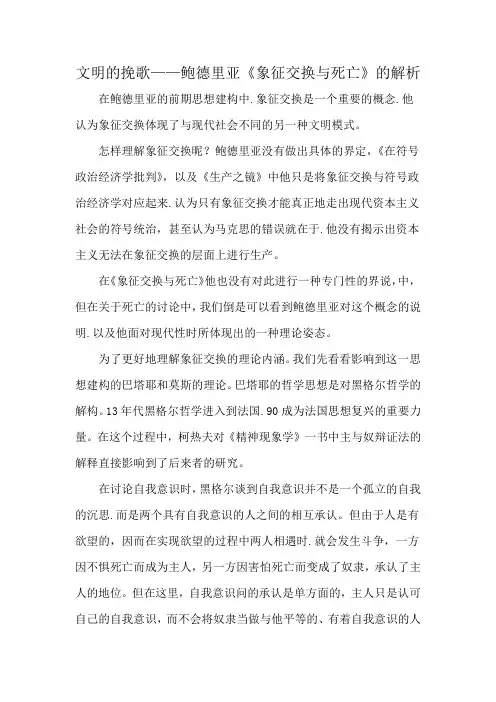
文明的挽歌——鲍德里亚《象征交换与死亡》的解析在鲍德里亚的前期思想建构中.象征交换是一个重要的概念.他认为象征交换体现了与现代社会不同的另一种文明模式。
怎样理解象征交换昵?鲍德里亚没有做出具体的界定,《在符号政治经济学批判》,以及《生产之镜》中他只是将象征交换与符号政治经济学对应起来.认为只有象征交换才能真正地走出现代资本主义社会的符号统治,甚至认为马克思的错误就在于.他没有揭示出资本主义无法在象征交换的层面上进行生产。
在《象征交换与死亡》他也没有对此进行一种专门性的界说,中,但在关于死亡的讨论中,我们倒是可以看到鲍德里亚对这个概念的说明.以及他面对现代性时所体现出的一种理论姿态。
为了更好地理解象征交换的理论内涵。
我们先看看影响到这一思想建构的巴塔耶和莫斯的理论。
巴塔耶的哲学思想是对黑格尔哲学的解构。
13年代黑格尔哲学进入到法国.90成为法国思想复兴的重要力量。
在这个过程中,柯热夫对《精神现象学》一书中主与奴辩证法的解释直接影响到了后来者的研究。
在讨论自我意识时,黑格尔谈到自我意识并不是一个孤立的自我的沉思.而是两个具有自我意识的人之间的相互承认。
但由于人是有欲望的,因而在实现欲望的过程中两人相遇时.就会发生斗争,一方因不惧死亡而成为主人,另一方因害怕死亡而变成了奴隶,承认了主人的地位。
但在这里,自我意识问的承认是单方面的,主人只是认可自己的自我意识,而不会将奴隶当做与他平等的、有着自我意识的人来看待,奴隶承认了主人的自我意识,但却失去了自己。
对主人的承认使奴隶在主人的命令与恐吓下,压抑着自己的欲望,进行劳动,就是黑格尔所说的“这劳动陶冶自然”的过程。
但也正是在这个过程中,奴隶发现面对自然界的强大力量,自己才是真正的主人,离开了自己。
主人什么也不是。
这时主与奴关系就会发生颠倒,奴隶才真正地实现了自我意识所具有的相互承认的内在要求。
这也推动了自我意识的进一步发展,斯多噶意识、怀疑意识和苦恼意识.都是以此为基础才得以产生。
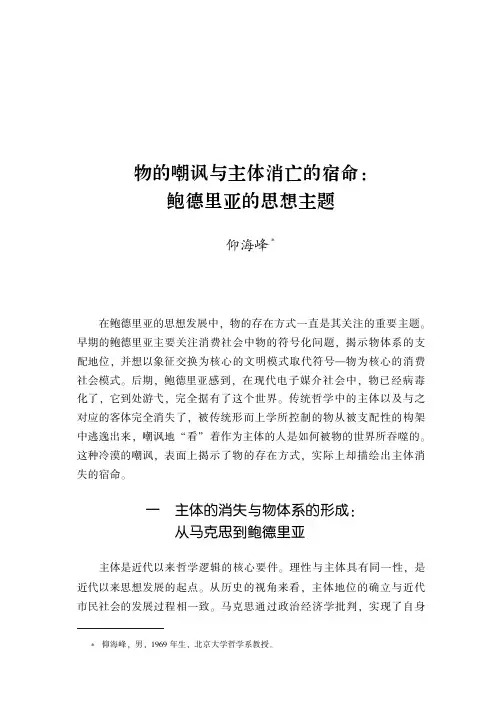
物的嘲讽与主体消亡的宿命:鲍德里亚的思想主题仰海峰*在鲍德里亚的思想发展中,物的存在方式一直是其关注的重要主题㊂早期的鲍德里亚主要关注消费社会中物的符号化问题,揭示物体系的支配地位,并想以象征交换为核心的文明模式取代符号 物为核心的消费社会模式㊂后期,鲍德里亚感到,在现代电子媒介社会中,物已经病毒化了,它到处游弋,完全据有了这个世界㊂传统哲学中的主体以及与之对应的客体完全消失了,被传统形而上学所控制的物从被支配性的构架中逃逸出来,嘲讽地 看 着作为主体的人是如何被物的世界所吞噬的㊂这种冷漠的嘲讽,表面上揭示了物的存在方式,实际上却描绘出主体消失的宿命㊂一主体的消失与物体系的形成:从马克思到鲍德里亚主体是近代以来哲学逻辑的核心要件㊂理性与主体具有同一性,是近代以来思想发展的起点㊂从历史的视角来看,主体地位的确立与近代市民社会的发展过程相一致㊂马克思通过政治经济学批判,实现了自身仰海峰,男,1969年生,北京大学哲学系教授㊂的思想转变,即从早期强调主体㊁理性的思想转向了从社会历史中考察主体㊁理性的思想,将人置于社会关系的网络中加以考察㊂在这一新的视角中,主体不再处于社会历史与哲学逻辑的中心位置,任何关于孤立主体的想象都只是对市民社会的意识形态认同(这主要是就马克思思想的内在逻辑来说的㊂在历史发展的过程中,对于没有经历过市场经济的社会,在日益全球化的时代,总是难以逾越个体主体占主导地位的历史时段)㊂在‘1857 1858年经济学手稿“导言中,马克思在谈到生产中的个人时指出,这些具有一定社会性质的个人才是出发点㊂ 被斯密和李嘉图当作出发点的单个的孤立的猎人和渔夫,属于18世纪的缺乏想象力的虚构㊂ 其实,这是对于16世纪以来就作了准备,而在18世纪大踏步走向成熟的 市民社会 的预感㊂ 这种18世纪的个人,一方面是封建社会形式解体的产物,另一方面是16世纪以来新兴生产力的产物,而在18世纪的预言家看来(斯密和李嘉图还完全以这些预言家为依据),这种个人是曾在过去存在过的理想;在他们看来,这种个人不是历史的结果,而是历史的起点㊂ ①因此,个人是被社会结构所架构的,在商品社会也是如此㊂在‘资本论“第一卷中,马克思讨论了商品拜物教㊂他指出,在商品普遍化时代,平常的物具有了非同寻常的神秘性,使人拜倒在自己面前,这就是商品拜物教㊂这里的拜物教具有两重含义㊂在表层,拜物教意味着人跪倒在自己的创造物面前,这是对直接存在的物的崇拜;在深层上,物之所以能占据这种 崇高 的位置,源于它在社会体系结构中的地位㊂因此,对社会体系中的物的崇拜,说到底是对这一社会结构本身的崇拜,这时拜物教的 物 不再是具体的存在物,而是一种抽象的看不见的社会关系,当人们崇拜具体的物的时候,对相应社会关系的崇拜与认同却被遮蔽了㊂商品拜物教表明,在商品普遍化的时代,主体只是一种理性的想象,实际上是被一种看不见的抽象体系所规制的㊂在这种体系的表层,就是传统哲学中所谓主体与客体的关系,或者说是有欲望的人与作为对象的物的关系㊂但从深层上来说,有欲望㊁有目的的个人,恰恰是被社会系统所整合㊁所同921物的嘲讽与主体消亡的宿命:鲍德里亚的思想主题 җҗ ‘马克思恩格斯全集“第30卷,人民出版社1995年版,第22 25页㊂031җҗ 哲学篇化的㊂从现代社会的变迁来看,马克思的拜物教批判关注的是资本主义早期阶段,即自由竞争的资本主义阶段㊂19世纪后期,特别是在20世纪初,随着以泰勒制㊁福特主义为表征的机器大工业的推广,生产的机械化使人日益成为生产系统的螺丝钉㊂正是在这样的历史语境中,卢卡奇以马克思的商品拜物教批判为理论基础,通过整合齐美尔与韦伯的学说,提出了物化理化㊂与马克思相比,卢卡奇更加强调社会生产层面的人的物化生存状态,这是人进入自动化系统的结果,人的物化过程也可以说是人被自动化的物体系所编织的过程㊂面对主体㊁人被物化的状态,卢卡奇从以黑格尔为中介的历史辩证法出发,力图重新确立主体的批判立场,以阶级意识扬弃物化意识㊂这种确立主体地位的理论想象,经过‘启蒙辩证法“与‘单向度的人“的理论,走向了自身的反面,即主体已经被技术理性架构了㊂法兰克福学派的批判理论揭示出,随着工具理性的全面扩张,人真的成为技术铁笼中的 囚者 ㊂这也表明随着现代社会的发展,主体越来越成为客体㊁物的编织物㊂这一思路直接影响到鲍德里亚关于物体系的支配地位的思考㊂在当时的法国,反思传统哲学的主体理念是当时哲学研究的一个核心主题㊂从鲍德里亚的思想建构方面来说,除了马克思以及由此形成的西方马克思主义之外,还受到索绪尔开创的结构语言学与拉康在承继弗洛伊德精神分析学的去主体化的思路的影响㊂在‘精神现象学“中,黑格尔在讨论 感性确定性 时认为,人要想把感性经验的东西表达出来,就会遇到 共相 ,因此,感性确定性的 真理 在于 共相 概念 ㊂正是从这里,黑格尔的哲学实现了从感性经验到理性的过渡㊂从语言学的视角来看,黑格尔的这一论述将语言不言自明地看成了主体的表达工具㊂在同时代的索绪尔看来,语言的这种表达功能并不来自主体的指令,而是由语言自身的差异结构所决定的㊂由符号构成的语言可分为音响系统的能指与表达概念含义的所指,能指之间的差异决定了所指的意义㊂因此,语言自身的结构性差异系统才是语言表达功能的基础㊂在这种理解中,语言不再是主体表达的工具,主体反而成为语言表达的载体㊂。
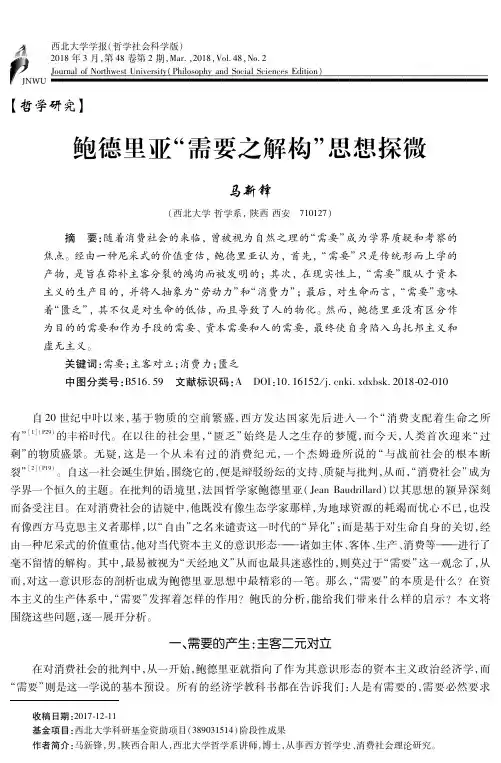
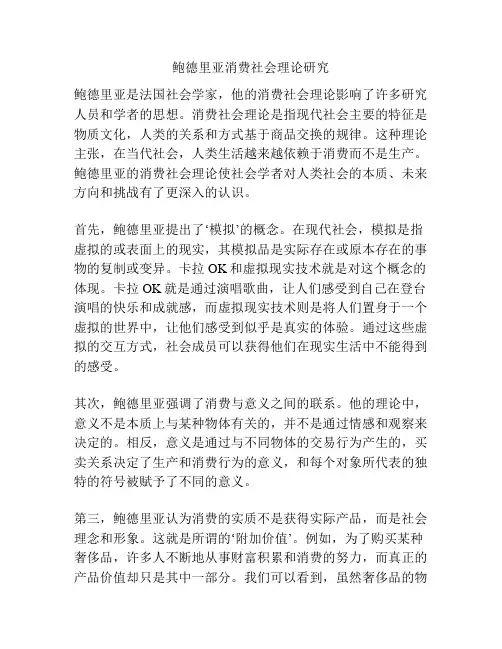
鲍德里亚消费社会理论研究鲍德里亚是法国社会学家,他的消费社会理论影响了许多研究人员和学者的思想。
消费社会理论是指现代社会主要的特征是物质文化,人类的关系和方式基于商品交换的规律。
这种理论主张,在当代社会,人类生活越来越依赖于消费而不是生产。
鲍德里亚的消费社会理论使社会学者对人类社会的本质、未来方向和挑战有了更深入的认识。
首先,鲍德里亚提出了‘模拟’的概念。
在现代社会,模拟是指虚拟的或表面上的现实,其模拟品是实际存在或原本存在的事物的复制或变异。
卡拉OK和虚拟现实技术就是对这个概念的体现。
卡拉OK就是通过演唱歌曲,让人们感受到自己在登台演唱的快乐和成就感,而虚拟现实技术则是将人们置身于一个虚拟的世界中,让他们感受到似乎是真实的体验。
通过这些虚拟的交互方式,社会成员可以获得他们在现实生活中不能得到的感受。
其次,鲍德里亚强调了消费与意义之间的联系。
他的理论中,意义不是本质上与某种物体有关的,并不是通过情感和观察来决定的。
相反,意义是通过与不同物体的交易行为产生的,买卖关系决定了生产和消费行为的意义,和每个对象所代表的独特的符号被赋予了不同的意义。
第三,鲍德里亚认为消费的实质不是获得实际产品,而是社会理念和形象。
这就是所谓的‘附加价值’。
例如,为了购买某种奢侈品,许多人不断地从事财富积累和消费的努力,而真正的产品价值却只是其中一部分。
我们可以看到,虽然奢侈品的物质价值在持续的时光中变得越来越不平凡,但消费愈发增长。
鲍德里亚进一步指出,当理念或形象被完全消费掉时,消费者的幸福感也会迅速降低。
例如,购买汽车可以带来快乐和满足感,但对于一些人来说,这种高傲的满足感只是短暂的。
他们需要不断地购买新的东西来保持这种感觉,直到幸福感消失。
所以,鲍德里亚认为,消费者经常在附加价值中追求他们所渴望的东西,但许多人并不了解自己真正需要的是什么。
最后,鲍德里亚在他的‘消费社会’理论中指出,商品的意义取决于它所代表的价值类型。
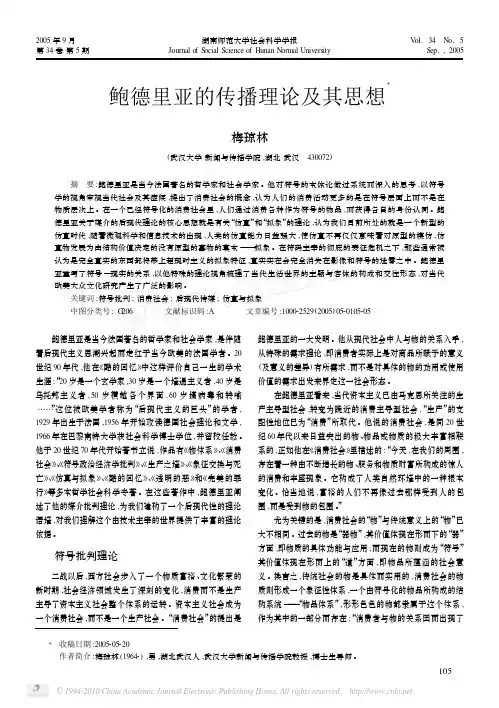
2005年9月第34卷第5期湖南师范大学社会科学学报Journal of S ocial Science of Hunan N ormal UniversityV ol.34 N o.5Sep.,2005鲍德里亚的传播理论及其思想Ξ梅琼林(武汉大学新闻与传播学院,湖北武汉 430072)摘 要:鲍德里亚是当今法国著名的哲学家和社会学家。
他对符号的本体论做过系统而深入的思考,以符号学的视角审视当代社会及其症候,提出了消费社会的概念,认为人们的消费活动更多的是在符号层面上而不是在物质层次上。
在一个已经符号化的消费社会里,人们通过消费各种作为符号的物品,而获得各自的身份认同。
鲍德里亚关于媒介的后现代理论的核心思想就是有关“仿真”和“拟象”的理论,认为我们目前所处的就是一个新型的仿真时代,随着微观科学和信息技术的出现,人类的仿真能力日益强大,使仿真不再仅仅意味着对原型的模仿,仿真物发展为由结构价值决定的没有原型的事物的摹本———拟象。
在符码主宰的彻底的表征危机之下,那些通常被认为是完全真实的东西都将带上超现时主义的拟象特征,真实实在会完全消失在影像和符号的迷雾之中。
鲍德里亚重写了符号—现实的关系,以他特殊的理论视角梳理了当代生活世界的主题与客体的构成和交往形态,对当代欧美大众文化研究产生了广泛的影响。
关键词:符号批判;消费社会;后现代传媒;仿真与拟象中图分类号:G206 文献标识码:A 文章编号:100022529(2005)0520105205 鲍德里亚是当今法国著名的哲学家和社会学家,是伴随着后现代主义思潮兴起而走红于当今欧美的法国学者。
20世纪90年代,他在《酷的回忆》中这样评价自己一生的学术生涯:“20岁是一个玄学家,30岁是一个境遇主义者,40岁是乌托邦主义者,50岁横越各个界面,60岁搞病毒和转喻……”这位被欧美学者称为“后现代主义的巨头”的学者, 1929年出生于法国,1956年开始攻读德国社会理论和文学, 1966年在巴黎南特大学获社会科学博士学位,并留校任教。
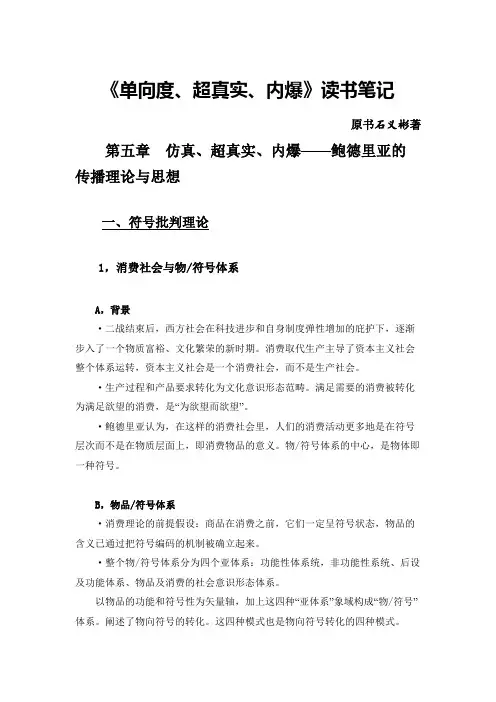
《单向度、超真实、内爆》读书笔记原书石义彬著第五章仿真、超真实、内爆——鲍德里亚的传播理论与思想一、符号批判理论1,消费社会与物/符号体系A,背景·二战结束后,西方社会在科技进步和自身制度弹性增加的庇护下,逐渐步入了一个物质富裕、文化繁荣的新时期。
消费取代生产主导了资本主义社会整个体系运转,资本主义社会是一个消费社会,而不是生产社会。
·生产过程和产品要求转化为文化意识形态范畴。
满足需要的消费被转化为满足欲望的消费,是“为欲望而欲望”。
·鲍德里亚认为,在这样的消费社会里,人们的消费活动更多地是在符号层次而不是在物质层面上,即消费物品的意义。
物/符号体系的中心,是物体即一种符号。
B,物品/符号体系·消费理论的前提假设:商品在消费之前,它们一定呈符号状态,物品的含义已通过把符号编码的机制被确立起来。
·整个物/符号体系分为四个亚体系:功能性体系统,非功能性系统、后设及功能体系、物品及消费的社会意识形态体系。
以物品的功能和符号性为矢量轴,加上这四种“亚体系”象域构成“物/符号”体系。
阐述了物向符号的转化。
这四种模式也是物向符号转化的四种模式。
C,物品/符号逻辑要成为消费对象,物品必须成为符号,也就是外在于一个它只作意义指涉的关系。
它和这个具体关系之间,存在的是一种任意的和不一致的关系,而它的合理一致性,也就是它的意义,来自于它和所有其他的符号-物之间,抽象而系统性的关系。
它被消费,但被消费的不是它的物质性,而是它的差异性。
2,符号消费中构建的消费文化·消费文化以资本主义商品生产增衍为前提。
资本主义生产的扩张,提供了大量可供消费的产品,建立了大量为消费而设的场所。
·社会消费中普遍存在“零和博弈”现象,人们通过社会差异的表现来取得某种社会认可,显示自身。
·消费文化所创造的影响以其直接、独特的方式给人以身体刺激和审美快感。
·鲍德里亚把符号作为物与人之间的中介,把商品生产放在了符号意义、能指-所指结构内,从而从更广阔的范围内破译了商品对文化的侵蚀。
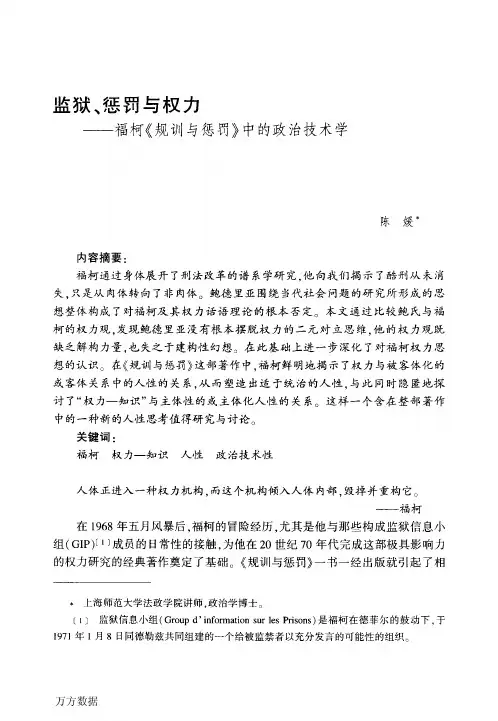
监狱、惩罚与权力——福柯《规训与惩罚》中的政治技术学陈媛+内容摘要:福柯通过身体展开了刑法改革的谱系学研究,他向我们揭示了酷刑从未消失.只是从肉体转向了非肉体。
鲍德里亚围绕当代社会问题的研究所形成的思想整体构成了对福柯及其权力话语理论的根本否定。
本文通过比较鲍氏与福柯的权力观.发现鲍德里亚没有根本摆脱权力的二元对立思维,他的权力观既缺乏解构力量,也失之于建构性幻想。
在此基础上进一步深化了对福柯权力思想的认识。
在《规训与惩罚》这部著作中,福柯鲜明地揭示了权力与被客体化的或客体关系中的人性的关系.从而塑造出适于统治的人性,与此同时隐匿地探讨了“权力一知识”与主体性的或主体化人性的关系。
这样一个含在整部著作中的一种新的人性思考值得研究与讨论。
关键词:福柯权力一知识人性政治技术性人体正进入一种权力机构,而这个机构倾入人体内部,毁掉并重构它。
——福柯在1968年五月风暴后,福柯的冒险经历.尤其是他与那些构成监狱信息小组(GIP)[1]成员的日常性的接触,为他在20世纪70年代完成这部极具影响力的权力研究的经典著作奠定了基础。
《规训与惩罚》一书一经出版就引起了相+上海师范大学法政学院讲师,政治学博士。
[1]监狱信息小组(Group d’in foH Il at ion surles蹦sons)是福柯在德菲尔的鼓动下,于1971年1月8日同德勒兹共同组建的一个给被监禁者以充分发言的可能性的组织。
监狱、惩罚与权力337当大的反响。
福柯起初思考的问题是:监狱形成的理由到底是什么?他觉得历史学家和社会学家们的解释并没有看到问题的本质。
据他观察,监禁最根本的目的是打造一套对人的新技术,并将其普遍化。
在这本书中福柯以惩罚和规训(作为体现权力关系的一种个案)为对象,写的不是刑事制度的演变史.而是“从中解读出权力关系和对象关系的一部共同历史.”[2]也就是18~19世纪以来人在西方社会的灵魂改造史,即人性变迁的机理。
福柯自己明确表明他著书的目的是在论述关于现代灵魂与一种新的审判权力之间相互关系的历史,论述现行的科学——法律综合体的谱系。
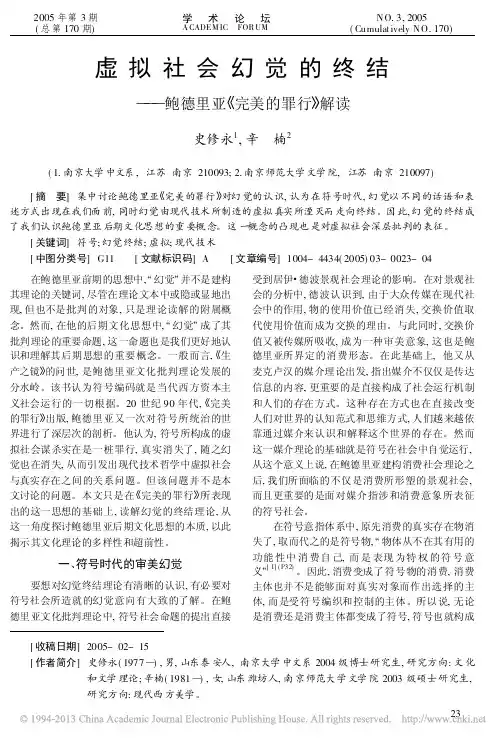
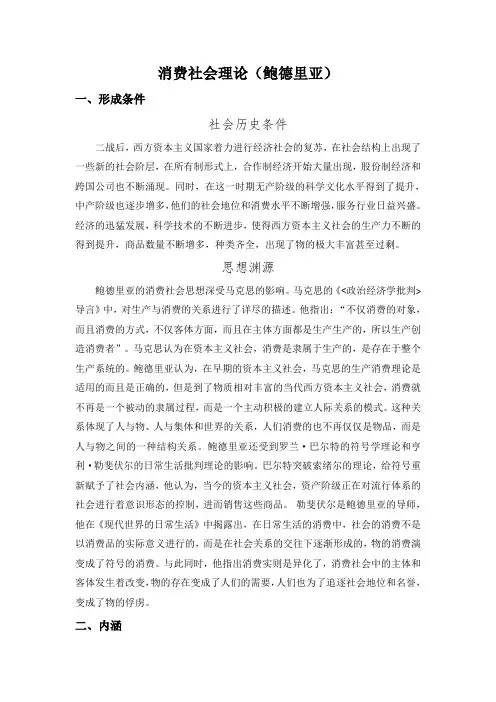
消费社会理论(鲍德里亚)一、形成条件社会历史条件二战后,西方资本主义国家着力进行经济社会的复苏,在社会结构上出现了一些新的社会阶层,在所有制形式上,合作制经济开始大量出现,股份制经济和跨国公司也不断涌现。
同时,在这一时期无产阶级的科学文化水平得到了提升,中产阶级也逐步增多,他们的社会地位和消费水平不断增强,服务行业日益兴盛。
经济的迅猛发展,科学技术的不断进步,使得西方资本主义社会的生产力不断的得到提升,商品数量不断增多,种类齐全,出现了物的极大丰富甚至过剩。
思想渊源鲍德里亚的消费社会思想深受马克思的影响。
马克思的《<政治经济学批判>导言》中,对生产与消费的关系进行了详尽的描述。
他指出:“不仅消费的对象,而且消费的方式,不仅客体方面,而且在主体方面都是生产生产的,所以生产创造消费者”。
马克思认为在资本主义社会,消费是隶属于生产的,是存在于整个生产系统的。
鲍德里亚认为,在早期的资本主义社会,马克思的生产消费理论是适用的而且是正确的,但是到了物质相对丰富的当代西方资本主义社会,消费就不再是一个被动的隶属过程,而是一个主动积极的建立人际关系的模式。
这种关系体现了人与物、人与集体和世界的关系,人们消费的也不再仅仅是物品,而是人与物之间的一种结构关系。
鲍德里亚还受到罗兰·巴尔特的符号学理论和亨利·勒斐伏尔的日常生活批判理论的影响。
巴尔特突破索绪尔的理论,给符号重新赋予了社会内涵,他认为,当今的资本主义社会,资产阶级正在对流行体系的社会进行着意识形态的控制,进而销售这些商品。
勒斐伏尔是鲍德里亚的导师,他在《现代世界的日常生活》中揭露出,在日常生活的消费中,社会的消费不是以消费品的实际意义进行的,而是在社会关系的交往下逐渐形成的,物的消费演变成了符号的消费。
与此同时,他指出消费实则是异化了,消费社会中的主体和客体发生着改变,物的存在变成了人们的需要,人们也为了追逐社会地位和名誉,变成了物的俘虏。
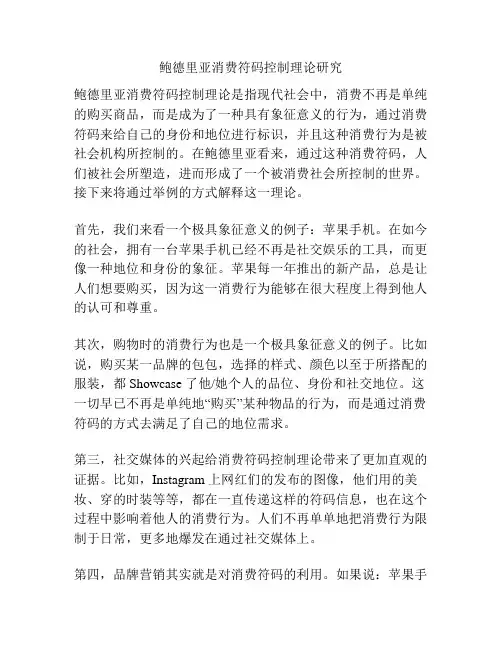
鲍德里亚消费符码控制理论研究鲍德里亚消费符码控制理论是指现代社会中,消费不再是单纯的购买商品,而是成为了一种具有象征意义的行为,通过消费符码来给自己的身份和地位进行标识,并且这种消费行为是被社会机构所控制的。
在鲍德里亚看来,通过这种消费符码,人们被社会所塑造,进而形成了一个被消费社会所控制的世界。
接下来将通过举例的方式解释这一理论。
首先,我们来看一个极具象征意义的例子:苹果手机。
在如今的社会,拥有一台苹果手机已经不再是社交娱乐的工具,而更像一种地位和身份的象征。
苹果每一年推出的新产品,总是让人们想要购买,因为这一消费行为能够在很大程度上得到他人的认可和尊重。
其次,购物时的消费行为也是一个极具象征意义的例子。
比如说,购买某一品牌的包包,选择的样式、颜色以至于所搭配的服装,都 Showcase 了他/她个人的品位、身份和社交地位。
这一切早已不再是单纯地“购买”某种物品的行为,而是通过消费符码的方式去满足了自己的地位需求。
第三,社交媒体的兴起给消费符码控制理论带来了更加直观的证据。
比如,Instagram 上网红们的发布的图像,他们用的美妆、穿的时装等等,都在一直传递这样的符码信息,也在这个过程中影响着他人的消费行为。
人们不再单单地把消费行为限制于日常,更多地爆发在通过社交媒体上。
第四,品牌营销其实就是对消费符码的利用。
如果说:苹果手机对于象征身份和地位的符码,那么品牌营销则包括对于各种需求的符码。
比如,某些品牌的广告总是强调其使用的物料的优越、设计独特等,旨在引导消费者认为“这个品牌就是好的、高档的、和众不同的”。
这样的符码其实将人们引导到了一种“情感诉求”和“精神满足”的另一种层面上,又来挑战消费行为的理性。
最后,通过对于教育消费的观察,也能够证明鲍德里亚消费符码控制理论。
现在的教育已经不局限于课程上的学习,而是包括社交层面的及个人状态的要求。
“好学生”、“top生”,其实为一种语言符码,通过符号的引导,对于消费者也就是学生,强制地接受了潜意识里所要求的身份,让消费者逐步地适应这一标识,从而加强了消费符码的实际作用。
Baudrillard: A New McLuhan?By Douglas KellnerDuring the 1980s, Jean Baudrillard has been promoted in certain circles as the new McLuhan, as the most advanced theorist of the media and society in the so-called postmodern era.[1] His theory of a new, postmodern society rests on a key assumption that the media, simulations, and what he calls "cyberblitz" constitute a new realm of experience and a new stage of history and type of society. To a large extent, Baudrillard's work consists in rethinking radical social theory and politics in the light of developments of the consumer, media, information, and technological society. Baudrillard's earlier works focus on the construction of the consumer society and how it provides a new world of values, meaning, and activity, and thus inhabit the terrain of Marxism and political economy. From the mid-1970s on, however, reflections on political economy and the consumer society disappear almost completely from his texts, and henceforth simulations and simulacra, media and information, science and new technologies, and implosion and hyperreality become the constituents of a new postmodern world which -- in his theorizing -- obliterate all the boundaries, categories, and values of the previous forms of industrial society while establishing new forms of social organization, thought, and experience.Among Baudrillard's most provocative theses are his reflections on the role of the media in constituting the postmodern world. Indeed, he provides paradigmatic models of the media as all-powerful and autonomous social forces which produce a wide range of effects.[2] To explicate the development and contours of his positions on the media, I shall follow his reflections from the late 1960s to the present, and sort out what I consider to be his contributions and limitations. I shall also be concerned to delineate the political implications of his media theory and to point to alternative theoretical and political perspectives on the media.Baudrillard's Postmodern Media TheoryIn 1967, Baudrillard wrote a review of Marshall McLuhan's _Understanding Media_ in which he claimed that McLuhan's dictum that the "medium is the message" is "the very formula of alienation in a technical society," and he criticized McLuhan for naturalizing that alienation.[3] At this time, he shared the neo-Marxian critique of McLuhan as a technological reductionist and determinist. By the 1970s and 1980s, however, McLuhan's formula eventually became the guiding principle of his own thought.Baudrillard begins developing his theory of the media in an article "Requiem for the Media" in _Toward a Critique of the Political Economy of the Sign_ (1972). The title is somewhat ironic for Baudrillard is really only beginning to develop a social theory inwhich the media will play crucial roles in constituting a new postmodernity. Thus Baudrillard is really writing a requiem here for a 'Marxist theory of the media' arguing: "McLuhan has said, with his usual Canadian-Texan brutalness, that Marx, the spiritual contemporary of the steam engine and railroads, was already obsolete in his lifetime with the appearance of the telegraph. In his candid fashion, he is saying that Marx, in his materialist analysis of production, had virtually circumscribed productive forces as a privileged domain from which language, signs and communication in general found themselves excluded" (CPES, p. 164). Baudrillard's critique of Marx here begins a radical interrogation of and eventual break with Marxism which would culminate in _The Mirror of Production_ (1973). Baudrillard begins distancing himself from Marxism in "Requiem for the Media," and in particular attacks Marx's alleged economic reductionism, or "productivism," and the alleged inability of the Marxian theory to conceptualize language, signs, and communication (Habermas at the time was developing a parallel position within Critical Theory).[4]As an example of the failure of Marxian categories to provide an adequate theory of the media, Baudrillard criticizes the German activist and writer Hans Magnus Enzensberger's media theory and his attempts to develop a socialist strategy for the media.[5] Baudrillard dismisses this effort as a typical Marxian attempt to liberate productive forces from the fetters of productive relations that fails to see that in their very form the mass media of communication "are anti-mediatory and intransitive. They fabricate non communication -- this is what characterizes them, if one agrees to define communication as an exchange, as a reciprocal space of a speech and a response, and thus of a responsibility (not a psychological or moral responsibility, but a personal, mutual correlation in exchange) .... they are what always prevents response, making all processes of exchange impossible (except in the various forms of response simulation, themselves integrated in the transmission process, thus leaving the unilateral nature of the communication intact). This is the real abstraction of the media. And the system of social control and power is rooted in it" (CPES, pp. 169-170).It is curious that Baudrillard, interpreted by many of his followers as an avant-garde, postmodern media theorist, manifests in this passage both technophobia and a nostalgia for face-to-face conversation which he privileges (as authentic communication) over debased and abstract media communication. Such a position creates a binary dichotomy between "good" face-to-face communication and "bad" media communication, and thus occludes the fact that interpersonal communication can be just as manipulative, distorted, reified, and son on, as media communication (as Ionesco and Habermas, among others, were aware), while ruling out in advance the possibility of "responsible" or "emancipatory" media communication -- a point that I shall return to in conclusion.In another study in the _Critique of the Political Economy of the Sign_, Baudrillard noted how the "TV Object" was becoming the center of the household and was serving an essential "proof function" that the owner was a genuine member of the consumer society (CPRES, pp. 53ff.). The accelerating role of the media in contemporary society is for Baudrillard equivalent to THE FALL into the postmodern society of simulations from the modern universe of production. Modernity for Baudrillard is thus the era of productioncharacterized by the rise of industrial capitalism and the hegemony of the bourgeoisie while postmodern society is an era of simulation dominated by signs, codes, and models. Modernity thus centered on the production of things -commodities and products -- while postmodernity is characterized by radical semiurgy, by a proliferation of signs. Furthermore, following McLuhan, Baudrillard interprets modernity as a process of explosion of commodification, mechanization, technology, and market relations, while postmodern society is the site of an implosion of all boundaries, regions, and distinctions between high and low culture, appearence and reality, and just about every other binary opposition maintained by traditional philosophy and social theory. F urthermore, while modernity could be characterized as a process of increasing differentiation of spheres of life (Max Weber as interpreted by Habermas), postmodernity could be interpreted as a process of de-differentiation and attendent implosion.[6]The rise of the broadcast media, especially television, is an important constituent of postmodernity for Baudrillard, along with the rapid dissemination of signs and simulacra in every realm of social and everyday life. By the late 1970s, Baudrillard interprets the media as key simulation machines which reproduce images, signs, and codes which constitute an autonomous realm of (hyper)reality and which come to play a key role in everyday life and the obliteration of the social.[7] Baudrillard's analyses of simulations and hyperreality probably constitute his most important contributions to social theory and media critique. During an era when movie actors simulate politics and charlatans simulate TV-religion the category of simulation provides an essential instrument of radical social critique, while the concept of hyperreality is also an extremely useful instrument of social analysis for a media, cybernetic, and information society. Baudrillard's analyses point to a significant reversal of the relation between representation and reality. Previously, the media were believed to mirror, reflect, or represent reality, whereas now the media are coming to constitute a (hyper)reality, a new media reality -- "more real than real" -- where "the real" is subordinate to representation leading to an ultimate dissolving of the real. In addition, in "The Implosion of Meaning in the Media," Baudrillard claims that the proliferation of signs and information in the media obliterates meaning through neutralizing and dissolving all content -- a process which leads both to a collapse of meaning and the destruction of distinctions between media and reality. In a society supposedly saturated with media messages, information and meaning "implode," collapsing into meaningless "noise," pure effect without content or meaning. Thus, for Baudrillard: "information is directly destructive of meaning and signification, or neutralizes it. The loss of meaning is directly linked to the dissolving and dissuasive action of information, the media, and the mass media.... Information devours its own contents; it devours communication and the social.... information dissolves meaning and the social into a sort of nebulous state leading not at all to a surfeit of innovation but to the very contrary, to total entropy" (SSM, pp. 96-100).Baudrillard uses here a model of the media as a black hole of signs and information which absorb all contents into cybernetic noise which no longer communicates meaningful messages in a process of implosion where all content implodes into form. We thus see here how Baudrillard eventually adopts McLuhan's media theory as his own,claiming that: "the medium is the message signifies not only the end of the message, but also the end of the medium. There are no longer media in the literal sense of the term (I am talking above all about the electronic mass media) -- that is to say, a power mediating between one reality and another, between one state of the real and another -- neither in content nor in form. Strictly speaking this is what implosion signifies: the absorption of one pole into another, the short-circuit between poles of every differential system of meaning, the effacement of terms and of distinct oppositions, and thus that of the medium and the real. Hence the impossibility of any mediation, of any dialectical intervention between the two or from one to the other, circularity of all media effects. Hence the impossibility of a sense (meaning), in the literal sense of a unilateral vector which leads from one pole to another. This critical -- but original -- situation must be thought through to the very end; it is the only one we are left with. It is useless to dream of a revolution through content or through form, since the medium and the real are now in a single nebulous state whose truth is undecipherable" (SSM, pp. 102-103).In effect, Baudrillard is suggesting that the very project of developing a radical theory of the media is impossible because there really are no "media" in the sense of institutions and cultural machines mediating between dominant political and economic powers and the population below. He claims that the media and "reality" implode such that it is impossible to distinguish between media representations and the "reality" which they supposedly represent. Baudrillard also suggests that the media intensify massification by producing mass audiences and massification of ideas and experience. On the other hand, he claims that the masses absorb all media content, neutralize, or even resist, meaning, and demand and obtain more spectacle and entertainment, thus further eroding the boundary between media and "the real." In this sense, the media implode into the masses to an extent that it is unknowable what effects the media have on the masses and how the masses process the media.Consequently, on this view, the media pander to the masses, reproducing their taste, their interest in spectacle and entertainment, their fantasies and way of life, producing an implosion between mass consciousness and media phantasmagoria. In this way, Baudrillard shortcircuits the manipulation theory which sees media manipulation imposed from above producing mass consciousness, yet he seems to share the contempt for the masses in standard manipulation theory claiming that they want nothing more than spectacle, diversion, entertainment and escape, and are incapable of, or uninterested in, producing meaning.In any case, since the media and the masses liquidate meaning, it is meaningless to carry out ideological critiques of media messages since the "medium is the message" in the sense that media communication has no significant referents except its own images and noise which ceaselessly refer back and forth to other media images and spectacles. In_On Seduction_ (1979), Baudrillard utilizes McLuhan's distinction between "hot" and "cool" media to describe the ways that media devour information and exterminate meaning. According to Baudrillard, the media take "hot" events like sports, wars, political turmoil, catastrophes, etc. and transform them into "cool" media events, which he interprets as altogether another kind of event and experience. Concerning thedifference between a televised and attended sports event, Baudrillard writes: "Do not believe that it is a matter of the same game: one is hot, the other is cool -- one is a contest where affect, challenge, mise en scene, and spectacle are present, whereas the other is tactile, modulated (visions in flash-back, replays, close-ups or overhead views, various angles, etc.): a televised sports event is above all a televised event, just as _Holocaust_ or the Vietnam war are televised events of which one can hardly make distinctions" (SED, p. 217).For Baudrillard, eventually, all the dominant media become "cool," erasing McLuhan's (problematical) distinction between hot and cool media. That is, for Baudrillard all the media of information and communication neutralize meaning and involve the audience in a flat, one-dimensional media experience which he defines in terms of a passive absorption of images, or a resistance of meaning, rather than the active processing or production of meaning. The electronic media therefore on this account have nothing to do with myth, image, history, or the construction of meaning (or ideology). Television is interpreted instead as a media "which suggests nothing, which magnetises, which is only a screen, or is rather a miniaturized terminal which in fact is found immediately in your head -- you are the screen and the television is watching you. Television transistorizes a ll neurons and operates as a magnetic tape -- a tape not an image" (SED, p. 220). Baudrillard, McLuhan and the Ecstasy of CommunicationWe see here how Baudrillard out-McLuhans McLuhan in interpreting television, and all other media, simply as technological forms, as machines which produce primarily technological effects in which content and messages, or social uses, are deemed irrelevant and unimportant. We also see how, like McLuhan, he anthropomorphizes the media ("the television is watching you"), a form of technological mysticism (or to be more nasty, mystification) as extreme as McLuhan. Like McLuhan, Baudrillard also globalizes media effects making the media demiurges of a new type of society and new type of experience. Baudrillard also practices McLuhan's method of probes and mosaic constellations of images and concepts which take on an experimental and provisional nature. Consequently, whereas he sets forth theoretically articulated theses about the media in "Requiem," in his studies of simulations and later writings he tends to cluster images, concepts, and descriptive analyses, within which media often play a key role, rather than systematically articulating a well-defined theoretical position, thus adopting a key McLuhanite literary strategy.Yet we might contrast here McLuhan's ecumenical Catholicism with Baudrillard's somewhat puritanical Protestantism.[8] McLuhan fantasized a new type of global community and even a new universal (media) consciousness and experience through the dissemination of a global media system, the global village. McLuhan also believed that the media could overcome alienation produced by the abstract rationality of book culture which was being replaced by a new synaesthesia and harmonizing of the mind and body, the senses and technologies. Baudrillard by contrast sees the media as external demigods, or idols of the mind -- to continue the Protestant metaphor --, which seduce and fascinatethe subject and which enter subjectivity to produce a reified consciousness and priva tized and fragmented life-style (Sartre's seriality). Thus while McLuhan ascribes a generally benign social destiny to the media, for Baudrillard the function of TV and mass media is to prevent response, to isolate and privatize individuals, and to trap them into a universe of simulacra where it is impossible to distinguish between the spectacle and the real, and where individuals come to prefer spectacle over "reality" (which both loses interest for the masses and its privileged status in philosophy and social theory).The mass media are thus instruments for Baudrillard of a "cold seduction" whose narcissistic charm consists of a manipulative self-seduction in which we enjoy the play of lights, shadows, dots, and events in our own mind as we change channels or media and plug into the variety of networks -- media, computer, information -- that surround us and that allow us to become modulators and controllers of an overwhelming panoply of sights, sounds, information, and events. In this sense, media have a chilling effect (which is why Baudrillard allows McLuhan's "cool" to become downright "cold") which freeze individuals into functioning as terminals of media and communication networks who become involved as part and parcel of the very apparatus of communication. The subject, then, becomes transformed into an object as part of a nexus of information and communication networks.The interiorization of media transmissions within the screen of our mind obliterates, he claims, the distinction between public and private, interior and exterior space -- both of which are replaced by media space. Here Baudrillard inverts McLuhan's thesis concerning the media as extensions of the human, as exteriorizations of human powers, and argues instead that humans internalize media and thus becomes terminals within media systems -- a new theoretical anti-humanism that might amuse Louis Althusser. The eye and the brain, on this model, replaces both the other sense organs and the hand as key instruments of human practice, as information processing replaces human practice and techne and poesis alike.[9]In "The Ecstasy of Communication" Baudrillard describes the media as instruments of obscenity, transparency, and ecstasy -- in special sense of these terms.[10] He claims that in the postmodern mediascape, the domestic scene -- or the private sphere per se -- with its rules, rituals, and privacy is exteriorized, or made explicit and transparent, "in a sort of obscenity where the most intimate processes of our life become the virtual feeding ground of the media (the Loud family in the United States, the innumerable slices of peasant or patriarchal life on French television). Inversely, the entire universe comes to unfold arbitrarily on your domestic screen (all the useless information that comes to you from the entire world, like a microscopic pornography of the universe, useless, excessive, just like the sexual close-up in a porno film): all this explodes the scene formerly preserved by the minimal separation of public and private, the scene that was played out in a restricted space" (p. 130).In addition, the spectacles of the consumer society and the dramas of the public sphere are also being replaced by media events that replace public life and scenes with a screen that shows us everything instantaneously and without scruple or hesitation: "Obscenitybegins precisely when there is no more spectacle, no more scene, when all becomes transparence and immediate visibility, when everything is exposed to the harsh and inexorable light of information and communication" (p. 130). The ecstasy of communication: everything is explicit, ecstatic (out of or beyond itself), and obscene in its transparency, detail, and visibility: "It is no longer the traditional obscenity of what is hidden, repressed, forbidden or obscure; on the contrary, it is the obscenity of the visible, of the all-too-visible, of the more-visible-than-visible. It is the obscenity of what no longer has any secret, of what dissolves completely in information and communication" (p. 131). One thinks here of such 1987 media obscenity concerning the trials and tribulations of Gary Hart and Donna Rice, of Jim Bakker and Jimmy Swaggart, of Ron and Nancy Reagans' cancer operations and astrology games, or the dirty business deals of his associates, and the dirty political deals of Iran/Contra -- all of which have been exposed to the glaring scrutiny of the media in which what used to be private, hidden, and invisible suddenly becomes (almost) fully explicit and visible.In the ecstasy of communication everything becomes transparent, and there are no more secrets, scenes, privacy, depth or hidden meaning. Instead a promiscuity of information and communication unfolds in which the media circulate and disseminate a teeming network of cool, seductive and fascinating sights and sounds to be played on one's own screen and terminal. With the disappearence of exciting scenes (in the home, in the public sphere), passion evaporates in personal and social relations, yet a new fascination emerges ("the scene excites us, the obscene fascinates us") with the very universe of media and communication. In this universe we enter a new form of subjectivity where we become saturated with information, images, events, and ecstasies. Without defense or distance, we become "a pure screen, a switching center for all the networks of influence" (p. 133). In the media society, the era of interiority, subjectivity, meaning, privacy, and the inner life is over; a new era of obscenity, fascination, vertigo, instantaneity, transparency and overexposure begins: Welcome to the postmodern world!In his more recent 1980 writings which I have not examined here -- and which tend to recycle (i.e. simulate) his earlier positions -- Baudrillard continues to call attention to McLuhan as the great media theorist of our epoch and continues to subscribe to the postions that I explicated above, though occasionally he notes that one should even go further than he has so far in denying that the media are producers of meaning, or that media content or apparatus is important.[11]Three SubordinationsUndoubtedly, the media are playing an ever greater role in our personal and social lives, and have dramatically transformed our economy, polity, and society in ways that we are only now becoming aware of. Living within a great transformation, perhaps as significant as the transformation from feudalism to industrial capitalism, we are engaged in a process of dramatic mutation, which we are barely beginning to understand, as we enter the brave new world of media saturation, computerization, new technologies, and new discourses. Baudrillard's contribution lies in his calling attention to these novelties and transformations and providing new concepts and theories to understand them.Yet doubts remain as to whether the media are having quite the impact that Baudrillard ascribes to them and whether his theory provides adequate concepts to analyze the complex interactions between media, culture, and society today. In this section, I shall suggest that Baudrillard's media theory is vitiated by three subordinations which undermine its theoretical and political usefulness and which raise questions as well about the status of postmodern social theory. I shall suggest that the limitations in Baudrillard's theory can be related to his uncritical assumption of certain positions within McLuhan's media theory and that therefore earlier critiques of McLuhan can accurately and usefully be applied to Baudrillard. This critique will suggest that indeed Baudrillard is a "new McLuhan" who has repackaged McLuhan into new postmodern cultural capital.First, in what might be called a formalist subordination, Baudrillard, like McLuhan, privileges the form of media technology over what might be called the media apparatus, and thus subordinates content, meaning, and the use of media to its purely formal structure and effects. Baudrillard -- much more so than McLuhan who at least gives some media history and analysis of the media environment -- tends to abstract media form and effects from the media environment and thus erases political economy, media production, and media environment (i.e. society as large) from his theory. Against abstracting media form and effects from context, I would argue that the use and effects of media should be carefully examined and evaluated in terms of specific contexts. Distinctions between context and use, form and content, media and reality, all dissolve, however, in Baudrillard's one-dimensional theory where global theses and glib pronouncements replace careful analysis and critique.Baudrillard might retort that it is the media themselves which abstract from the concreteness of everyday, social, and political life and provide abstract simulacra of actual events which themselves become more real than "the real" which they supposedly represent. Yet even if this is so, media analysis should attempt to recontextualize media images and simulacra rather than merely focusing on the surface of media form. Furthermore, instead of operating with a model of (formal) media effects, I would argue that it is preferable to operate with a dialectical perspective which posits multiple roles and functions to television and other media.Another problem is that Baudrillard's formalism vitates the project of ideology critique, and against his claims that media content are irrelevant and unimportant, I would propose grasping the dialectic of form and content in media communication, seeing how media forms constitute content and how content is always formed or structured, while forms themselves can be ideological, as when the situation comedy form of conflict/resolution projects an ideological vision which shows all problems easily capable of being resolved within the existing society, or when action-adventure series formats of violent conflict as the essence of reality project a conservative view of human life as a battleground where only the fittest survive and prosper.[12] For a dialectical theory of the media, television would have multiple functions (and potential decodings) where sometimes the ideological effects may be predominant while at other times time functions a medium like television functions as mere noise or through the merely formal effects which Baudrillard puts at the center of his analysis.。
当代艺术的消失?——鲍德里亚《濒临消亡的艺术》研究袁晓静【期刊名称】《《兰州教育学院学报》》【年(卷),期】2019(035)011【总页数】3页(P96-98)【关键词】纯粹的商品; 艺术的共谋; 幻觉的消失【作者】袁晓静【作者单位】河北师范大学文学院河北石家庄050000【正文语种】中文【中图分类】I01“为什么是空无一物,而非有些什么?”这是对莱布尼茨提问方式的一个颠倒,也是鲍德里亚后期思想中一个重要的逻辑主题——消失。
在《濒临消亡的艺术》里,鲍德里亚并不是要宣布艺术的死亡或终结,而是将“消失”作为他对艺术的一种言说方式。
他想说明当今艺术为何看似消失却没有消失,又为何濒临消失却仍有存活的希望。
在19世纪艺术经历商品的冲击以来,波徳莱尔已经为艺术选择了“绝对对象化”的致命策略,而当艺术变成与传统形态截然不同的“陌生物”时,它并未死亡或终结,而是以纯粹商品的样态获得了与商品化抗争的武器。
在这里,审美主体消失了,美学的道德原则消失了,传统的审美秩序消失了,但艺术没有消失。
可是当艺术发展到仿像的第二个阶段时,艺术的乌托邦已经实现,世界的审美化已经完成,艺术落入对自身的仿拟之中,不再拥有原初性的价值,并在技术的仿真中异化为危险的修补物,这时艺术的幻觉权力被剥夺,艺术面临着真正消亡的危险。
一、艺术:纯粹的商品在黑格尔的逻辑推演中,艺术最终要向更高的宗教和哲学演进,从而实现自身的终结。
而在19世纪发达的资本主义社会里,艺术面临的却是来自商业的威胁,针对这一不可逆转的情境,波徳莱尔发明了最初的激进的解决方案——绝对对象化,主张“艺术必须走上无法逃避的商品无差异的和使艺术品等同于纯粹商品的路径。
”[1]240这是一条激进的、无可奈何的选择,也是波徳莱尔在现代性的审美中所做的一个英雄的选择。
如阿冈本所说:“波徳莱尔的伟大之处恰恰在于,早在商品大举侵袭之前,就以将艺术作品转变为商品的物恋对象的方式回应了这种侵袭。
在国外马克思主义哲学发展中,除了从西方马克思主义向晚期马克思主义和后(现代)马克思主义的转变外,一个重要的逻辑转向就是从西方马克思主义到后马克思思潮的转变。
所谓后马克思思潮,主要指的是早期受到以西方马克思主义为中介的马克思批判理论的影响,但后来又明确反对马克思从生产逻辑出发来分析资本主义社会的学者。
在这个转变过程中,法国当代思想家让·鲍德里亚(Jean Baudrillard)是一位重要代表。
鲍德里亚1929年出生于法国东北部阿登斯省兰斯地区的一个农民家庭。
早年深受德国文化影响,阅读了尼采、海德格尔、荷尔德林、布莱希特等人的著作,并翻译了包括布莱希特《流亡者的对话》在内的一些重要德文著作。
1960年代中期之后,开始受萨特的影响并在其举办的《现代》上发表了三篇文学评论性文章。
1966年,鲍德里亚完成了自己的社会学研究并进入南特禾大学,先后在列斐伏尔与巴特的影响下完成了自己的博士论文《物体系》。
在此期间,鲍德里亚还受到了以原始文化研究批判现代社会的莫斯、巴塔耶的影响,除此之外,鲍德里亚实际上还受到了拉康、马尔库塞、德波、阿尔都塞、福柯、德里达、布尔迪厄、德鲁兹、克里斯托娃等左派思想家的影响,并在1968年参与《德意志意识形态》的法译工作。
鲍德里亚的思想发展大致可以分为三个阶段:第一阶段处于西方马克思主义批判理论的影响之下,并结合符号学与精神分析理论展开对消费社会的批判分析;第二阶段是从西方马克思主义转向后马克思思潮,对马克思的历史唯物主义展开了较为尖锐的批评,此时的鲍德里亚可以说是后现代主义的先驱;第三阶段是同一切现有思潮决裂,最后同现实本身决裂,走向了物体支配一切的阶段。
在本文的讨论中,主要分析鲍德里亚从西方马克思主义如何转向了后马克思思潮。
与传统的西方马克思主义相比,早期鲍德里亚的批判理论具有一些不同的质点。
传统的西方马克思主义,从卢卡奇到阿多诺,其直接的论述对象实际上是自动化生产的社会,卢卡奇的物化理论,霍克海默与阿多诺在《启蒙辩证法》中关于大众文化的批判,都是建立在这一现实基础上。
鲍德里亚的身体理论研究摘要::鲍德里亚认为,在整个消费社会中,身体是最美的消费品。
在对身体进行救赎运动中,我们的身体被同质化、外延化和功用化了,在女性解放和医学崇拜的背后是真实个人的被删除。
同时,身体在意识形态功能中彻底取代了灵魂成为了一种新的意识形态神话。
尽管鲍德里亚对人们身体的被奴役境地给予了无情揭露和批判,但他并没有向我们指出走出困境的道路,原因在于其对马克思主义的背离。
关键词:身体意识形态神话深层逻辑中图分类号:b506 文献标识码:a让·鲍德里亚作为法国著名的社会理论家,可以说是最具“原创性”的学术大师之一,被誉为后现代主义思潮的开创者和引路人。
在《消费社会》一书中,鲍德里亚通过对消费社会丰盛景观的详尽描述、对消费理论的深入剖析与反思,明确指出处在现代资本主义消费社会中人们的奴性境地。
人们无时无刻不被引导、被塑造、被区分、被编码、被支配和奴役,无时无刻不处在消费意识形态的统治之下。
然而在本书即将接近尾声之际,鲍德里亚笔锋一转,将关注的焦点转向了身体。
在笔者看来,鲍德里亚之所以如此关注身体理论,不仅在于鲍德里亚认为身体是最美的消费品,“它比负载了全部内涵的汽车还要负载了更沉重的内涵,”更重要的是,通过对作为消费品的身体的分析,更能突显作为主体的人们,在现代消费的资本逻辑面前是多么的苍白、脆弱与无奈。
一同质化、外延化与功用化鲍德里亚指出,我们的身体并不是一种明摆着的事实,从本质上讲,身体是一种文化事实,它反映着社会关系的组织模式。
通过身体,我们看到的是人类发展最本真最基本最直接的历史过程。
而这一点,在消费社会的今天,则体现得更为突出。
处在消费社会的人们,无时无刻地不被提醒,你们“只有一个身体,必须对它进行救赎”。
同时,人们也不时地被警告,“假如您不进行身体护理,假如因您疏忽而犯错,您就会受到惩罚。
您的一切痛苦,都是由您自己不负责的罪过造成的。
”于是,在广告、时尚和大众文化的影响下,人们不约而同地被卷入了一场身体的救赎与解放运动,卫生保健学、营养学、医疗学的此起彼伏,护理、健身、饮食时刻冲击着我们的神经,献身于香水、按摩、疗养的人们越来越为常见。
或许,沸沸扬扬的“悟本事件”、“道长李一”就是这一救赎运动的真实写照。
据此,正是在这样的一场救赎运动中,我们的身体被同质化、外延化和功用化了。
首先,对于与主体相对的客观身体,我们对它“进行的操作就像在‘处女地’和‘殖民地’上进行地操作一样,它把身体当做一座有待开发的矿藏一样进行‘温柔地’开发,以使它在时尚市场上表现出幸福、健康、美丽、得意动物性的可见符号”,因此,每一个消费者必须把自己的身体当成物品,当成最美的物品,当成最珍贵的交换材料。
所以,在消费社会中,身体和物品等同了,它和物品构成了一个同质符号网。
并且,人们开发自己身体的最终目的在于提高自己的交换价值,以显性的可见符号来表现自我、提升自我、凸显自我。
同质化的必然结果是外延化。
在消费的深层机制中,身体的重新开发首先要经过物品,身体的解放必然要外延到身体以外的物品中去。
因此,在这一意义上讲,身体的解放和开发必然意味着人们对物品的追求与消费,其必然的结果就是购物冲动的解放。
于是,我们看到的是急急忙忙进入美容院、健身房的女(男)人,他们一直忙着献身于香水、按摩和疗养。
也正是在这样的逻辑支配下,一种效益经济的程式建立起来了,与身体相关的一切领域都成为了资本追逐的场所,都成为了发掘利润的策源地。
身体异化的突出表现是其功用性特征。
其中美丽和色情是两个核心主题。
美丽既不是自然的效果,也和道德品质无关。
但是,对于女性来说,它却是绝对命令,因为它是“交换着的符号的一种材料,它是作为价值/符号运作着的”,它是资本的一种形式。
因为身体在这里发生了一种蜕变——从具体价值、使用价值向功用性交换价值的蜕变。
而作为另一个功用性主题的色情,其在消费社会中的一个典型特征则是交换的普遍化,它与本来意义上的性欲是具有明显不同的。
“在身体/冲动、身体/幻觉中占主导地位的是欲望的个体结构。
而在‘色情化’的身体中,起主导地位的则是交换的社会功能。
”因此,在消费社会中,功用性的色情必然要受到工具化编码的约束,支配它的是像礼貌和礼仪一样的普遍规则。
于是,就模特而言,她们的身体不再是欲望的客体,而只能是功用性的客体,是时尚符号和色情符号的混合而已,或者更直接地说是一种广告载体的物品而已。
二身体——新的意识形态神话鲍德里亚指出,“为身体进行的长期去魅及世俗化贯穿了整个西方历史中,身体的价值曾在于其颠覆性价值,它是意识形态最尖锐矛盾的策源地。
”在很长时间里,在对以灵魂或其他某种非物质原则为中心的唯灵论、说教性意识形态进行攻击批判的过程中,身体一直处于核心地位并发挥着极为重要的作用。
然而,在消费社会的今天,身体自己却成了神话、教条和救赎模式,并在此基础上建立起了一整套社会一体化及控制目标,重新肩负起了意识形态功能。
被解放了的身体——这种更具功用性的当代意识形态,说它比以往所有意识形态更具欺骗性和虚假性,其根本原因在于作为新意识形态神话的身体保护的是个人主义价值体系及相关的社会结构,它用一种自发、完全显性的表现取代了完全内在的灵魂超验性。
然而,“当代神话构建的身体并不比灵魂更加物质。
它,和后者一样,是一种观念”。
因此,我们认为尽管身体具有了物质的表象,但它依旧是意识形态,并且是一种新的更具神话色彩的意识形态。
因此,身体成为了指导整个消费领域的核心原则,并进而在整个消费伦理中享有超验的特权。
于是,身体最终演变为了经济支柱、成为了指导个体的心理一体化原则和社会控制的政治策略,成为了新的意识形态神话。
三身体意识形态神话中的现象学分析身体意识形态的表现具有广泛性、多样性和全面性的特点。
但最能体现其特色的莫过于关于女性解放的神话与医学崇拜了。
也正是在身体这种新的意识形态的引导与控制之下,女性解放、医学崇拜等一切关于解放和实现的神话,都如火如荼地进行着。
在消费社会的今天,女性真的被解放了吗?答案是否定的。
鲍德里亚指出,“某些女人的解放,在某种程度上,只是庞大战略操作的二手利润、散落的尘埃、借口”而已,与此相联系的仅仅是某种功用性实践。
我们必须看到,在女性解放的神话中发生了一个严重的混淆,亦即女性越来越混同于自己的身体,与其说是女性解放,不如说是身体解放。
以前,女性是作为性被奴役的,今天则作为性被解放。
于是,一个必然的逻辑就是,“女性通过性解放被‘消费’,性解放通过女性被‘消费’”。
在这种逻辑的支配下,女性日益演化为一种时尚与前卫的消费品。
并且,更为重要的是,女性解放并未实现,因为它同其他一切构成当代社会的主题范畴一样,都是建立在“监护”价值体系之上的。
而恰恰就是这种监护体系,把身体这种最具革命性,并因而构成对任何一种既成秩序最根本威胁的因素一体化了,统统被回收到了解放的神话之中,于是,身体再也不是什么最具破坏性颠覆性的力量,转而成为了一体化和控制力最强的新的意识形态。
同时,也正是在这种新的意识形态的统治之下,现代医学也发生了质的转型。
可以说,传统医疗的操作对象,是实际的身体。
假如它出了毛病,医生就会恢复身体的神力,使它重新回归于一种客观的存在,身体并没有成为人们进行自我救赎和自我标榜的手段。
然而,在当今的消费社会中,医疗除了治疗功能之外更具有了一种文化效力,因为,人们不但要对自己的身体进行救赎,还要通过其来标注自己的地位。
因此,与其说健康是与活下去息息相关的生理命令,不如说它是与地位息息相关的社会命令,于是,医生在很大程度上变成了“听告解者”、“赦罪者”、“主祭修士”。
更为重要的是,现代医学是建立在一种竞争性和强制性逻辑之上的,人们变本加厉的非理性乃至疯狂地进行着消费,对医疗、外科、药剂服务有着无限要求,而其中或许并没有丝毫的治疗目的。
四结语1 启示通过以上论述,鲍德里亚让我们清醒地认识到,在消费社会中,尽管我们对自己的身体百般呵护,但到头来,我们的身体很难说是属于我们自己的,我们对身体的开发与占有,依据的很难说是主体的自主目标。
“鲍德里亚认为,当代资本主义消费结构中……起根本性支配作用的东西,就是由符号话语制造出来的暗示性的结构性意义和符号价值。
……消费主体不是个人,在现代消费中,真实的个人消费恰恰是被删除了的。
”同时,鲍德里亚还让我们进一步认识到,在整个身体意识形态神话的背后,起支配地位的恰恰是功用性、效益和资本的逻辑。
人们对自己身体的自恋式投入,实际上只不过是一种竞争的经济投入,一开始就唯“资本主义”目的马首是瞻。
在消费社会中,身体在某种意义上被当成了劳动力,它必须“被解放、获得自由”,以便它能够因为生产性目的而被合理地开发。
并且,我们说,同样也正是在资本逻辑的支配下,美丽和色情都呈现出功用性的特征。
2 困境在对人们身体的被奴役境地给予无情揭露和批判的同时,鲍德里亚是否向我们指出了走出困境的道路呢?答案是否定的。
本文之所以有这样的指认,是建立在对鲍德里亚在《消费社会》结语中阐释的有关《布拉格的大学生》电影故事的解读之上的。
鲍德里亚之所以在本书的结语中引用这样一个电影故事,恰恰是鲍德里亚消费社会思想的真实写照。
对于影片中大学生以金子换影像直至最后的死亡。
鲍德里亚的评述是这样的:“这一影像并非偶然被丢失或取消了的——它是被出卖了的。
它堕入了商品的范畴,或许可以说,这恰是具体的社会性异化的意义”。
同时,大学生最后不可避免的死亡也向我们暗示,鲍德里亚认为异化是无法超越的,除了死亡之外别无出路。
可以说,这就是鲍德里亚对消费社会未来的定位。
《终结的幻觉》是鲍德里亚90年代抛出的阐述其历史观的小册子,其基本观点就是:“由于现代技术使人类社会进入了‘倒计时’状态,因而在世纪交替之际,鲍德里亚悲天悯人地发出了‘历史终结了’的呼唤”。
在鲍德里亚的视野中,被塑形的客体消失了,物性生产破碎了,真实缺席了,痛苦被狂欢所代替。
因此,鲍德里亚没有成功地构建出真正的能动理论,尽管在他的一生中,“他始终保持一种胜利者的姿态,一种反叛消费和媒介社会的姿态。
”3 反思鲍德里亚没有给我们指出摆脱消费社会困境的道路,并不意味着我们真的无路可走,它只能说明鲍德里亚走错了方向而已。
笔者认为,鲍德里亚最关键的错误在于他没有厘清资本与文化的关系,将消费意识形态与消费文化作为了支配整个后工业消费社会的轴心结构。
我们说,鲍德里亚并没有向我们指出符号统治背后的真正动力,是什么原因让符号、编码具有如此之大的神奇魔力并变化莫测。
或者更为明确的说,鲍德里亚并没有沿着马克思资本的逻辑继续前行,他背离了马克思,也就迷失了方向,从而也就失去了对消费社会进行批判的核心武器。
正如学者张一兵指出的那样,“鲍德里亚从来就没有成为过一个马克思主义者,即便在最初”。